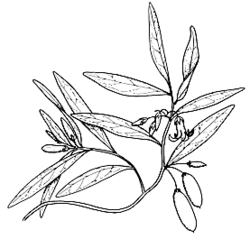Common name: Pale Appleberry, Sweet Appleberry
Billardiera versicolor F.Muell. ex Klatt APNI* 
Description: Robust shrubby twiner or scrambler, stems to a few metres long.
Adult leaves alternate, mostly narrowly elliptic, 36–60 mm long, 6–13 mm wide, glabrous; margin usually recurved, never undulate; petiole 1–2 mm long, with lamina extending to base.
Inflorescences terminal, mostly sessile, corymbose to umbel-like, up to 12-flowered. Sepals 2–3 mm long, yellow-green. Petals 8–14 mm long, separating above the middle, initially white, cream-coloured or pale yellow, with spreading mauve-red blotches from throat with age; apex hairy. Stamens often 4 with one staminode; filaments tapering; anthers oblong, white. Ovary 5–7 mmlong; style c. 0.5 mm long; stigma large capitate.
Fruits bilocular, berry-like, obloid, 13–15 mm long, glabrous, green; seeds numerous, thin discoidal.
Flowering: Flowers spring to mid–summer.
Distribution and occurrence: Common; chiefly from West Wyalong to the Balranald area; Vic. & SA. Grows in mallee communities on sandy soils and ironstone gravel.
NSW subdivisions: CWS, SWP, SFWP
Other Australian states: Vic. S.A.
Text by B.J. Conn
Taxon concept: L.W. Cayzer, M.D. Crisp & I.R.N. Telford (2004)
APNI* Provides a link to the Australian Plant Name Index (hosted by the Australian National Botanic Gardens) for comprehensive bibliographic data
***The AVH map option provides a detailed interactive Australia wide distribution map drawn from collections held by all major Australian herbaria participating in the Australian Virtual Herbarium project.
|


